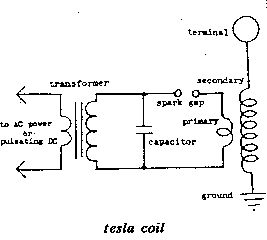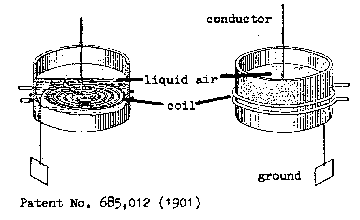

 Tesla’s best-known invention takes the spark-gap oscillator and uses it to vibrate
vigorously a coil consisting of few turns of heavy conductor. Inside of this
primary coil sits another secondary coil with hundreds of turns of slender wire.
In the Tesla coil there is no iron core as in the conventional step-up transformer,
and this air-core transformer differs radically in other ways.
Tesla’s best-known invention takes the spark-gap oscillator and uses it to vibrate
vigorously a coil consisting of few turns of heavy conductor. Inside of this
primary coil sits another secondary coil with hundreds of turns of slender wire.
In the Tesla coil there is no iron core as in the conventional step-up transformer,
and this air-core transformer differs radically in other ways. A tesla-coil secondary has its own particular electrical character determined in part by the
length of that slender coiled wire. Like a guitar string of a particular length, it wants to
vibrate at a particular frequency. The secondary is inductively plucked by the primary coil.
The primary circuit consists of a pulsating high-voltage source (a generator or conventional
step-up transformer), a capacitor, a spark gap, and the primary coil itself. This circuit
must be designed so that it vibrates at a frequency compatible with the frequency at which
the secondary wants to vibrate.
A tesla-coil secondary has its own particular electrical character determined in part by the
length of that slender coiled wire. Like a guitar string of a particular length, it wants to
vibrate at a particular frequency. The secondary is inductively plucked by the primary coil.
The primary circuit consists of a pulsating high-voltage source (a generator or conventional
step-up transformer), a capacitor, a spark gap, and the primary coil itself. This circuit
must be designed so that it vibrates at a frequency compatible with the frequency at which
the secondary wants to vibrate.
Also in this chapter:
THE LOST INVENTIONS OF NIKOLA TESLA
by George Trinkaus
republished with permission of the author and publisher
High Voltage Press
4326 S,E. Woodstock, #489
Portland, OR 97206 USA